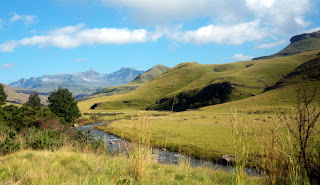April and its’ holiday break was very eventful as I participated in the Long Tom half-marathon and went hiking in the Drakensberg Mountains. Both activities were firsts and absolutely amazing!
 With support from stateside friends and family I was able to qualify and raise $150 to put towards the KLM foundation and participate in the Longtom half-marathon. The KLM foundation funds a scholarship program for very talented South African learners coming from disadvantaged homes. It was very moving to be involved in such a large event and our group of 50 Peace Corps Volunteers all running for KLM was really impressive. The most amazing long legged South Africans were in abundance and I felt honored to be in the presence of such talented athletes. Sabie and this marathon attracts a great number of participants because of the glorious Long Tom Pass, one of Mpumalanga Province’s most scenic areas. All but two of our PC bunch participated in the Half-marathon: 21 km, rather than the Ultra-marathon: 56 km, and were bused to our starting point. The almost hour drive up and across the mountains, I was blown away by the beauty and overjoyed to begin. It is really grand to have received support from back home for this event and been able to give to this worthy project. I am most definitely participating next year!
With support from stateside friends and family I was able to qualify and raise $150 to put towards the KLM foundation and participate in the Longtom half-marathon. The KLM foundation funds a scholarship program for very talented South African learners coming from disadvantaged homes. It was very moving to be involved in such a large event and our group of 50 Peace Corps Volunteers all running for KLM was really impressive. The most amazing long legged South Africans were in abundance and I felt honored to be in the presence of such talented athletes. Sabie and this marathon attracts a great number of participants because of the glorious Long Tom Pass, one of Mpumalanga Province’s most scenic areas. All but two of our PC bunch participated in the Half-marathon: 21 km, rather than the Ultra-marathon: 56 km, and were bused to our starting point. The almost hour drive up and across the mountains, I was blown away by the beauty and overjoyed to begin. It is really grand to have received support from back home for this event and been able to give to this worthy project. I am most definitely participating next year!
PC SA 16,17,18 Long Tom marathon participants

Afterwards our group cleaned and gathered for delicious brai eats and to catch up with volunteers from other programs. Catering to our minor aches and pains we had no idea what was in-store for us the next morning and week. 6am, our group of 15 climbed aboard a hatchback and set off to a taxi rank, where we negotiated with a gentleman to take our tired, sore and cranky butts to Sani. After 10 hours of sitting in a vehicle we had arrived.
 With backpacks jammed pack with travel snacks (various trail mixes, guava strips, the popular: Rusks, mouth-watering tuna packets, and peanut butter), water bottles, and thankfully first-aid kits we set off for the Giant’s Cup Trail, a self-guided, 3 day hike, that extends across the Drakensberg Mountains, the Zulu name, Ukhahlamba means “Battlement of Spears”. We passed through tall grasses, over rushing rivers, stepping this way and that through rains and sun shining days. Quite the interesting bunch, our group moved at varying paces but cared and encouraged each other as we all had our own mix of ailments.
With backpacks jammed pack with travel snacks (various trail mixes, guava strips, the popular: Rusks, mouth-watering tuna packets, and peanut butter), water bottles, and thankfully first-aid kits we set off for the Giant’s Cup Trail, a self-guided, 3 day hike, that extends across the Drakensberg Mountains, the Zulu name, Ukhahlamba means “Battlement of Spears”. We passed through tall grasses, over rushing rivers, stepping this way and that through rains and sun shining days. Quite the interesting bunch, our group moved at varying paces but cared and encouraged each other as we all had our own mix of ailments.  I moved along the way thinking of nothing other than how I love first times and being out in nature, venturing through this beautifully preserved land. We took water from the streams that are said to be safe despite the recent Cholera outbreaks in Zimbabwe. Rinsing my face in the cool traveling water and grasping a friend’s helpful hand, out with nature for a few days apart from lively culture; I felt cleansed by the physical activity and thoroughly enjoyed my time.
I moved along the way thinking of nothing other than how I love first times and being out in nature, venturing through this beautifully preserved land. We took water from the streams that are said to be safe despite the recent Cholera outbreaks in Zimbabwe. Rinsing my face in the cool traveling water and grasping a friend’s helpful hand, out with nature for a few days apart from lively culture; I felt cleansed by the physical activity and thoroughly enjoyed my time.
The first night, warming up to a chimney fire, eating roasted marshmallow with chocolate, we listened to favorite tunes on portable itunespeakers. The 2nd day of our hike we were lost for sometime and I was convinced we would be staying outside in the cold being unable to reach our nightspot before sun down. It was within the first 30 minutes of our day’s hike that we had lost our way. Navigating back to our trail was deemed impossible once we took to a course assumed to be ours requiring that we scale a mountain. However, we rather rewardingly discovered some fabulous San art.
 The San people and their rock-art is said to be 8,000 years old and depicts all sorts of traditional survival activity-hunting, historical events-coming of the white man, and traditional gender roles. The San, already under pressure from the tribes that had moved into the Drakensberg foothills, were finally destroyed with the coming of white settlers. The San art is found in caves all around the mountains in over 500 locations. The small paintings are only able to be seen by those that take the hikes out to the areas and were only discovered within the last 50 years. By far one of the coolest historical artifacts I have ever seen.
The San people and their rock-art is said to be 8,000 years old and depicts all sorts of traditional survival activity-hunting, historical events-coming of the white man, and traditional gender roles. The San, already under pressure from the tribes that had moved into the Drakensberg foothills, were finally destroyed with the coming of white settlers. The San art is found in caves all around the mountains in over 500 locations. The small paintings are only able to be seen by those that take the hikes out to the areas and were only discovered within the last 50 years. By far one of the coolest historical artifacts I have ever seen.
 our map-readers
our map-readers
After those shining moments things got a bit rough. Staring at our Topographic map, our 5 map-readers determined that our stay stop was just over the way down in the valley. However, we had no path to get down from the cave location and with having already stopped far too many times, we knew it was time to move on if we were going to get to our sleep spot in time. For 4 hours-real team work was in action, we helped one another slide down the hills, held hands and bags in support and ran ahead to ensure passage possible. Thankfully, one of the girls found the site we would stay at for the night tucked under a little place in the valley. How? I have no idea, it was dark and getting cold, I was prepared to open my sleeping bag. I had been praying to my Saint Christopher that I wore around my neck, he for sure had been watching over us.
Jo, best friend, nurse and travel planner
 In all this fun, I forgot to mention that I had been suffering. Our half-marathon run, prior to our hike had been fabulous and all but rather rough on my feet. My lousy shoes and continuous on-the-go travels only added to the uncomfortable situation. My dancer-feet have been worn down before but not like this. I am very thankful for the imitation nurses in our group, pulling together all the med equipment, assisting me with mending my wounds. On our travels back, I returned to headquarters for medical care and was told that my feet and their sores were both infected and was placed on antibiotics. I am well-recovered and running almost everyday. As the rain starts to pour down, I suppose an indoor yoga session will do just fine for today.
In all this fun, I forgot to mention that I had been suffering. Our half-marathon run, prior to our hike had been fabulous and all but rather rough on my feet. My lousy shoes and continuous on-the-go travels only added to the uncomfortable situation. My dancer-feet have been worn down before but not like this. I am very thankful for the imitation nurses in our group, pulling together all the med equipment, assisting me with mending my wounds. On our travels back, I returned to headquarters for medical care and was told that my feet and their sores were both infected and was placed on antibiotics. I am well-recovered and running almost everyday. As the rain starts to pour down, I suppose an indoor yoga session will do just fine for today.
 With the cold comes a golden tasty treat. South Africa is located in the southern hemisphere, our seasons are just opposite of U.S.A. and since the start of May we have entered the winter months. My home and stretched green grass yard provide me with plenty of fine gifts like room for yoga with my girls group or my favorite- morning fruit bites. With the passing of another cold night , I can waken to a new ripe Guava to sink my teeth into. Either yellow with a yellow center or green with a pink center, these pear necked fruits are just delightful.
With the cold comes a golden tasty treat. South Africa is located in the southern hemisphere, our seasons are just opposite of U.S.A. and since the start of May we have entered the winter months. My home and stretched green grass yard provide me with plenty of fine gifts like room for yoga with my girls group or my favorite- morning fruit bites. With the passing of another cold night , I can waken to a new ripe Guava to sink my teeth into. Either yellow with a yellow center or green with a pink center, these pear necked fruits are just delightful. When a different fruit tree has begun its blossoming, then I wait in anticipation for what delicious snack I will be able to pull from its limbs. With arrival usually comes a stomach ache as I snack on too many leaving me finished for the day only to grab a hold again tomorrow. In addition to stomach pains the guavas arrived with something else- a bit of diarrhea. Please excuse my t.m.i (too much information), travelers don't seem to have difficulty sharing these facts.
When a different fruit tree has begun its blossoming, then I wait in anticipation for what delicious snack I will be able to pull from its limbs. With arrival usually comes a stomach ache as I snack on too many leaving me finished for the day only to grab a hold again tomorrow. In addition to stomach pains the guavas arrived with something else- a bit of diarrhea. Please excuse my t.m.i (too much information), travelers don't seem to have difficulty sharing these facts.  I should mention that the pulpy center of the guava is nutty. Having never eaten this fruit before, I began my self-diagnosis, heredity pointed to diverticulitis (digestive disease found in the large intestine). With all this talk of swine flu and my host sister off in the hospital ill, my mind has been wandering. But with a bit of Googling, I am left feeling just right as I discover how much greater this Guava fruit really is. Not only is it an excellent source of Vitamin C, far more than most fruits but it promotes a healthy colon, and rids bacterial infections, therefore it is rather normal that it would be cleaning me like so. Could it be that this winter wonder has been keeping my freezing toes and nose in good health? Well, in any case I have increased my hand-washing and sanitizing as recommended. So pick yourself up some Guava juice! Don’t waste your taste with a sugared version, take a swig of 100% fruit and join me in soaking up some Vitamin C!
I should mention that the pulpy center of the guava is nutty. Having never eaten this fruit before, I began my self-diagnosis, heredity pointed to diverticulitis (digestive disease found in the large intestine). With all this talk of swine flu and my host sister off in the hospital ill, my mind has been wandering. But with a bit of Googling, I am left feeling just right as I discover how much greater this Guava fruit really is. Not only is it an excellent source of Vitamin C, far more than most fruits but it promotes a healthy colon, and rids bacterial infections, therefore it is rather normal that it would be cleaning me like so. Could it be that this winter wonder has been keeping my freezing toes and nose in good health? Well, in any case I have increased my hand-washing and sanitizing as recommended. So pick yourself up some Guava juice! Don’t waste your taste with a sugared version, take a swig of 100% fruit and join me in soaking up some Vitamin C!



















